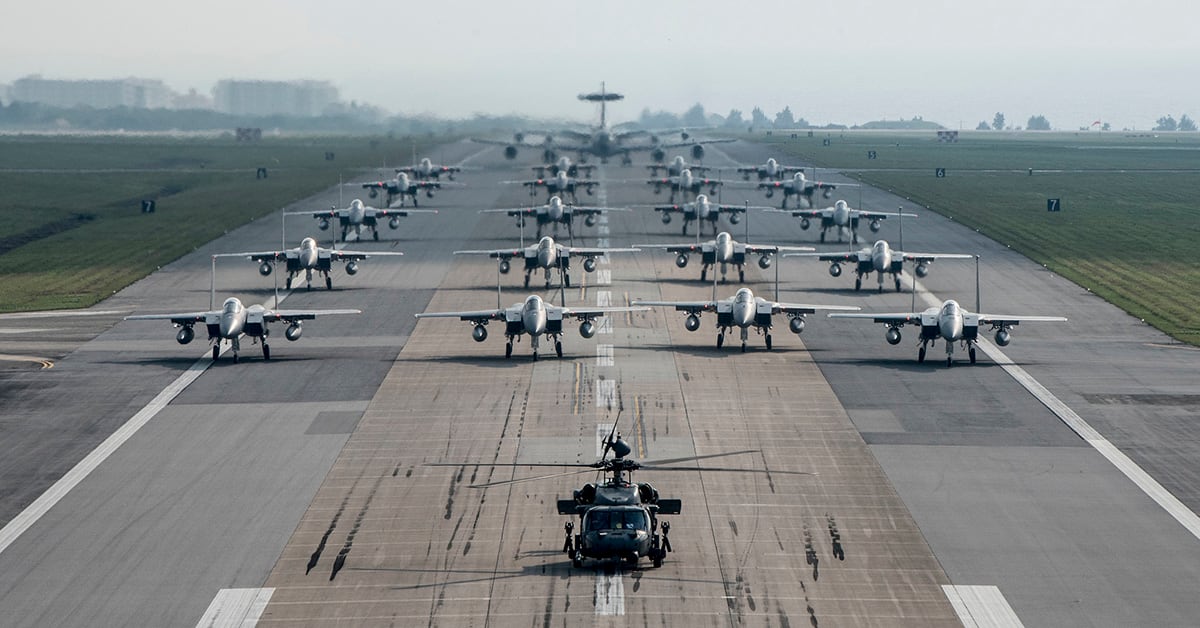On Sept. 17, Secretary of the Air Force Heather Wilson stole a page from the Army and the Navy, announcing that the Air Force needed to grow its number of operational squadrons by 25 percent, from 312 to 386. The Army and the Navy have both mastered the art of using absolute numbers of soldiers and ships, respectively, to describe what the future force should look like.
The strategy is clear: Give Congress and the public a big impressive number, and then argue anything less would put the nation at risk.
Who can blame them? Describing force structure needs with one single, specific, easily bumper-sticker-able number has proven effective in defending budgets on the Pentagon’s bureaucratic playground. However, thinking in these over-simplified and strictly numerical terms is actually bad for the safety of the nation — it allows decision-makers and those who hold them accountable to ignore the equally, if not more important, discussion of the qualitative capability of the joint force.
Let’s review the tape. During the course of the contraction in defense spending beginning in fiscal year 2013, Army leadership held fast to a requirement for 490,000 soldiers in the active component, in spite of clear direction in the 2012 Defense Strategic Guidance to reduce the size of U.S. ground forces. Similarly, the Navy’s 2016 Force Structure Assessment established a requirement for 355 ships, which Navy leadership invoked to support its budget request, describing it as “the Navy the nation needs.” Since then, the 355 number has taken on near-mystical importance.
RELATED

History suggests this focus on numbers worked as a means of grabbing defense dollars: Between the fiscal year 2018 and fiscal year 2019 defense budget requests, the Army grew by 10 percent, the Navy by eight percent, but the Air Force grew by only six percent.
So it’s hard to blame Secretary Wilson for taking this step, in light of the success the Army and Navy seem to have had with similar approaches.That said, is the Air Force actually too small? As always, the answer depends on what you want the Air Force to be able to do.
Using the new National Defense Strategy as a yardstick, it seems reasonably safe to say that the Air Force should grow if we want it to be able to best China and Russia while sustaining operations in the Middle East and continuing to support the joint force in mobility, space, and other areas. However, limiting the public dialogue around the Air Force’s requirements to a single number of operational squadrons cheats the nation out of the more critical conversation detailing what those squadrons need to be able to do and in what kinds of environments.
By focusing on the number, the debate treats a light attack squadron the same as an F-35 squadron. Pressure to meet the target number of squadrons run the risk of driving decisions to buy in higher volume at the less costly and less capable end of the spectrum, as we have seen in justifications of the continued buy of the Littoral Combat Ship above the Navy’s own requests for the platform.
Dumbing down the conversation about the Air Force’s future force structure to a single number can have serious consequences for the shape of the future joint force, ones that we will sorely regret given the United States’ eroding technological edge against China and Russia. We may get to the “right” number of squadrons, but whether or not they will be the right kinds of squadrons, with the right capabilities required to retain military advantage over near-peer competitors, is a separate question — one largely neglected by Wilson in her remarks.
RELATED

Although the Air Force has played this numbers game in the past, in recent years it has consistently been more focused on the future and the imperative to maintain U.S. military technological dominance than the other services, spending more on research and development and making difficult decisions to pursue the smaller but more capable force that the 2012 Defense Strategic Guidance called for.
Monday’s announcement portends a possible reversal of this approach. This about face is doubly troubling given that DoD is very likely at peak budget level, with another contraction a distinct possibility in the near term. The temptation to simplify the conversation about what the future Air Force needs to look like down to a single number is strong. However, doing so, particularly in a period of fiscal contraction, can result in aestrategic decisions to retain more force structure than the service can afford to keep fully modernized and ready.
By focusing only on quantity and foregoing the more nuanced and difficult discussion the qualitative capabilities the future Air Force will need, we risk neglecting the imperative to retain U.S. military advantage against China and Russia, which is the central security challenge of our time.
Susanna V. Blume is a Senior Fellow in the Defense Program at the Center for a New American Security, formerly Deputy Chief of Staff for Programs and Plans to the Deputy Secretary of Defense. Follow her on Twitter @SusannaVBlume.





